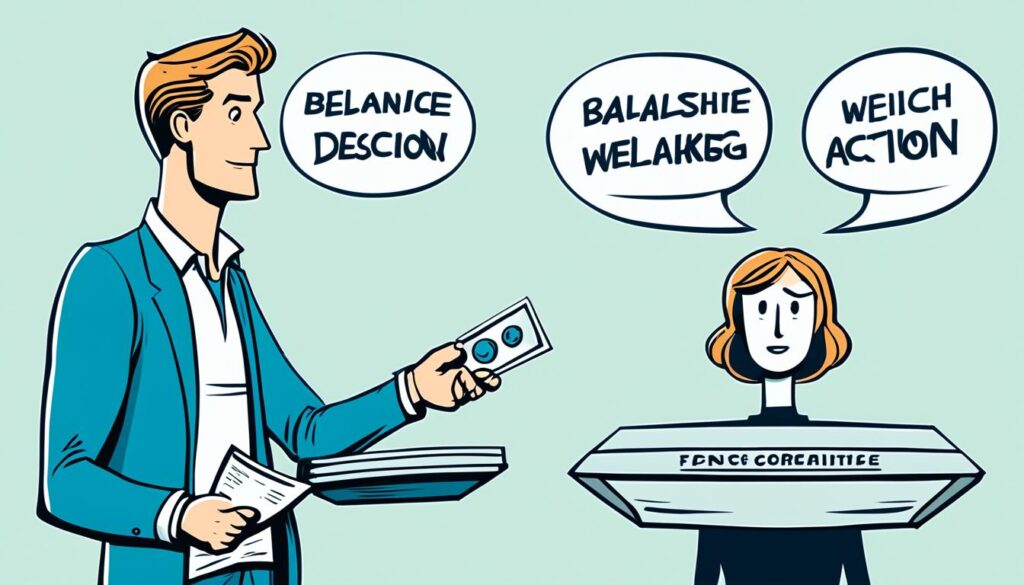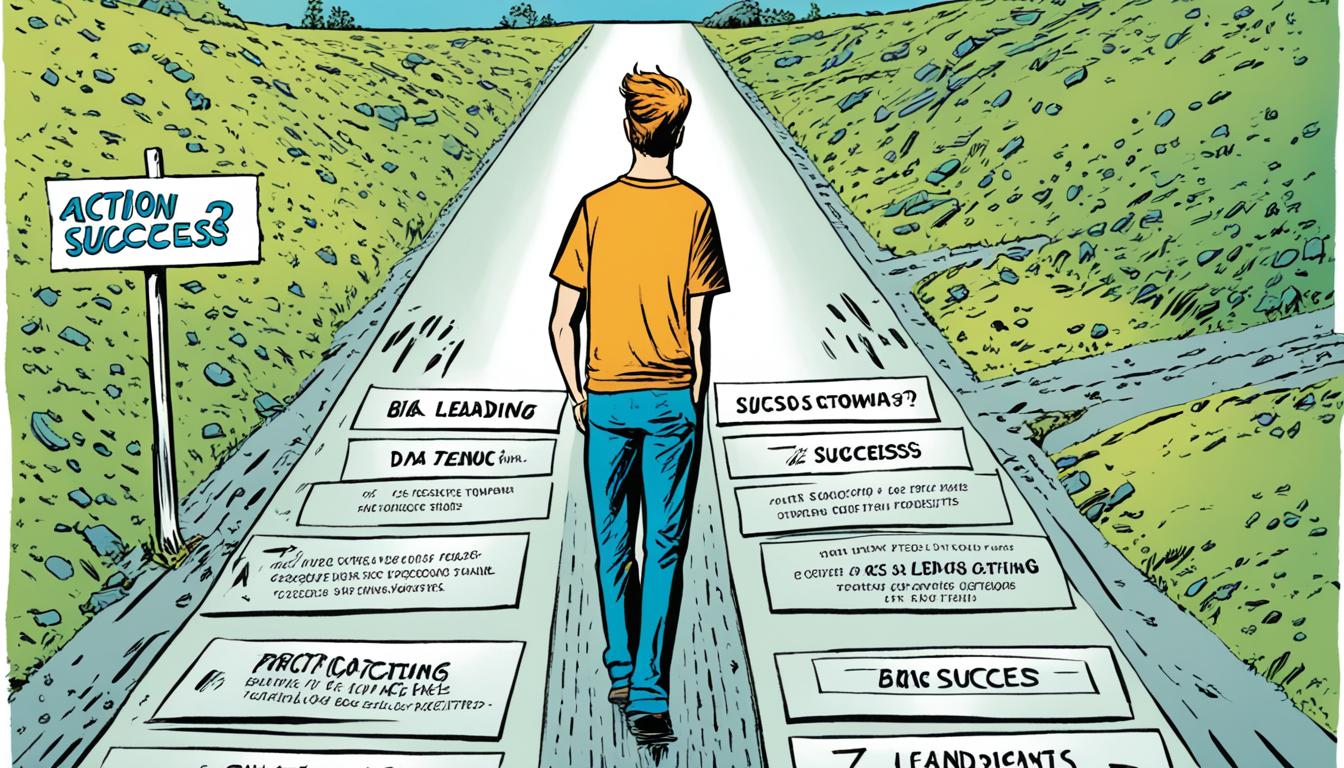A study on soccer goalkeepers reveals a fascinating finding: Goalkeepers have a higher chance of blocking penalty kicks when they remain still. This discovery is unexpected since it challenges the common belief that taking action is always preferable to inaction. This phenomenon is known as the action bias, which may not always result in optimal outcomes.
The action bias makes us want to act, thinking it’s better than doing nothing. It can be useful in urgent situations that need quick decisions. But, it can also make us rush, not think things through fully, and end up in worse situations.
Experts say this bias comes from how we react to past mistakes of not acting. Also, thinking too highly of our abilities can make us act when we shouldn’t, like making bad money moves that lead to losses.
But, knowing about the action bias can help us make better choices. We learn to think about if acting is really needed. Sometimes, not doing anything is the smarter choice.
This bias often shows up under pressure, like in business or investing. Wanting quick results or fearing we’ll miss out can make us rush decisions. Thinking carefully, assessing risks, and planning for the future are key to managing well.
In investing, this urge to act quickly can make us make choices that don’t help in the long run. Fear of losing out or quick market changes can push us to make rushed decisions. These decisions in trading can have big financial impacts.
Dealing with action bias in trading and investing is very important. A planned approach, thinking long-term, and making well-informed choices can lessen the bad side of rushing into actions. This leads to better results over time.
By controlling the action bias, we aim for smarter decision-making. Thinking about the results of our actions and if they’re really needed lets us make better choices. This improves our chances for success in what we do.
Key Takeaways:
- The action bias refers to our tendency to prioritize action over inaction, even when it may not lead to the best outcome.
- Rewarding action and punishing inaction can reinforce the action bias, influenced by negative past experiences.
- The action bias can lead to hasty decisions, insufficient analysis, and potentially detrimental outcomes.
- Balancing action bias with deliberation is essential for effective management and decision-making.
- Understanding and managing the action bias in trading and investing is critical for long-term success.
What is the Action Bias?
The action bias is when people prefer to act instead of doing nothing, even without good reasons. We see this in daily life and at work.
Humans have always acted quickly to survive and get what they need. Our ancestors who acted fast often found food and shelter. So, we inherited this need to jump into action.
For example, ex-athletes might find it hard to keep exercising regularly. Yet, some take on new challenges like running a marathon. It shows their need to stay active.
At Amazon, they value quick action. Their rule, “Bias for Action,” is about making fast decisions and taking smart risks. It helps them adapt quickly to new market trends.
In marketing and startups, acting fast is key. Businesses that change quickly to meet customer needs often do well. Understanding this can help in both work and personal growth.
The action bias isn’t just about rushing into things. Unlike “Just Do It,” it suggests thinking a little before acting. It’s flexible, letting people weigh their options and challenges.
Starting small is often best, according to chess champion Gary Kasparov. He believes it’s better to have any plan than none at all. This mentality focuses on learning as you go, not waiting for a perfect plan.
Where Does the Action Bias Occur?
The action bias pops up in different situations like when we make decisions or in groups at work. When deciding on something, people might jump into doing something without checking all the info they have. They want to show they’re making progress, not necessarily the right move. In companies, this kind of bias is pretty big.
In workplaces, there’s this idea that if you’re not doing something, you’re wrong. This pushes everyone into making quick choices without really thinking them through. If people rush into things, they might miss out on some critical stuff or ignore possible problems.
But, it’s not all bad. If a company knows how to deal with action bias, they can actually turn it into something good. Places like Amazon drive their teams to be bold and try new stuff. They live by a rule called the Bias for Action. This makes people more creative and good at solving problems.
Also, action bias is everywhere from politics to healthcare, sports, and even in how businesses are run. In healthcare, for instance, doctors might lean towards doing something like a procedure because of their biases. This can really change the kind of care patients get.
Patients too might want a quick fix like medication, even if it’s not the best move. They think taking action is better than waiting, even if there might be side effects.
In sports, take soccer goalies during penalties, for example. They dive to one side way more often than staying put. They think this looks better and might get them praise, even if it’s not the smartest choice.
When it comes to money and management, you see it too. Governments and banks feel they have to do something when the economy goes bad. They’re scared of being judged for doing nothing. Yet, when everything’s going well, they’re afraid to rock the boat.
All in all, action bias touches almost every choice we make, whether alone or in a group. However, if organizations really get it and push for action wisely, they can kick off a wave of new ideas and smart choices. Knowing when to act or wait is key to doing well over time.
Effects of the Action Bias
The action bias makes us prefer doing something over doing nothing. It influences our lives in many ways.
Individual Effects
The action bias has good and bad sides. Taking action can make us happier, healthier, and more successful. It helps people get past obstacles and grab opportunities.
But, it can also lead us to make hasty decisions. Sometimes, we solve problems in ways that don’t really work. And when we’re busy, we might not think deeply about our choices. This can keep us from achieving our best in the long run.
Systemic Effects
On a bigger scale, the action bias pushes society to value doing over thinking. It makes us think people who don’t act are to blame without understanding the full story. In policy-making, this leads to flashy but weak laws that don’t fix real issues.
However, successful companies today take time to think and plan. They use a careful approach to face challenges. This shows the value of deep thought in a complicated world.
Support from others can help those who struggle to take action. Accountability encourages them to move forward and reach their goals.
Understanding the action bias helps people and groups. By mixing action with thought, we make better choices. This leads to higher productivity and improved outcomes.

| Effects of the Action Bias | Examples |
|---|---|
| Positive Effects | – Increased happiness, better health – Higher chances of success |
| Negative Effects | – Creating solutions that do not solve problems – Lack of time for strategic thinking |
| Systemic Effects | – Perpetuation of a culture that values action over inaction – Implementation of showy but ineffective regulations |
To beat the action bias, we need patience. We should see the value in thinking, watching, and waiting. Embracing slow, thoughtful actions can lead to real success. By considering other ways to measure success, we unlock the full potential of careful action.
Action Bias in Product Management
In product management, action bias affects decision-making, especially with technical issues. Often, instead of analyzing the situation, there’s a rush to act, hoping for a quick fix.
This rush can harm when facing complex problems. The action bias makes people try quick fixes without waiting or seeking expert advice. This usually worsens the situation, leading to more problems.
“The action bias in product management can be likened to a person attempting to fix a leaky faucet by forcibly turning the knob, only to discover that it causes more water to spray everywhere.”
The same happens when using Artificial Intelligence (AI) in products. Some might choose AI without checking if it’s the best choice. They think technology will solve everything that could be better handled by humans.
AI can improve product management by adding efficiency and innovation. But, it’s important to balance the use of AI with human judgment. This way, technical solutions focus on real value and user needs, avoiding the traps of action bias.

Why Does the Action Bias Happen?
The action bias comes from our early days as hunter-gatherers. Acting fast was key to stay alive. Those who acted swiftly were more likely to succeed. This quick action tendency is part of our instincts now.
Also, society rewards us for taking action and getting results. In contrast, doing nothing is often seen negatively. This makes us think acting is always good, no matter what.
Studies show we prefer doing something over doing nothing. We think actions bring more value and better results. This belief shapes our decision-making and how we view our choices.
But, acting fast isn’t always the best. Sometimes, waiting and acting at the right time can be more valuable. Chinese philosophy talks about “non-doing” (wu wei). It shows the value of waiting for the right moment to act.
Beating the action bias needs patience and seeing the value in being slow and deliberate. Sometimes, not acting is the best move. It lets us collect more info, consider risks, and decide better.
The habit of acting can be tough to stop. Acting becomes a routine, and the rewards further encourage it. This makes it hard to choose inaction when it’s wise.
Understanding the action bias helps us make smarter choices. We can decide to act or not, choosing the most efficient path. Knowing this can make us more productive and better at deciding.

The Action Bias and Sense of Control
The action bias comes from our need to be in control. It affects how we make decisions and act. We think that by doing something, we can shape what happens. This makes us feel productive.
Being too sure of ourselves also fuels the action bias. We often think our actions matter more than they do. This can make us act when we should wait, believing we control things more than we actually do.
This urge to act can be seen everywhere, even at work. Companies like Amazon push for action over sitting still. They tell their leaders to act quickly, rather than waiting around.
At work, having to meet deadlines makes us hurry. We want to do things right away, even if we need more time to think. But acting too fast without a good plan can backfire.
Strong leadership and clear communication can help keep action bias positive. But, if bosses control every little thing, it can stop employees from acting on their own. This kills initiative and the will to act.
To find a good mix, knowing when to act is crucial. Organizations can benefit from acting swiftly if they also think things through. By understanding human behavior, companies can promote a smart way to be proactive.
In the end, the desire to act comes from our need to feel in charge. While it can motivate us, we need to balance it with careful planning. This way, we can avoid risks and achieve better results.

| Key Factors | Implications |
|---|---|
| Need for Control | Influences decision-making and behavior |
| Overconfidence | Leads to overestimating the impact of actions |
| Culture of Action | Promotes action over inaction in companies |
| Deadlines and Targets | Increase the urgency and reinforce action bias |
| Micromanagement | Can hinder employees’ action bias |
| Strategic Decision-Making | Crucial to avoid negative consequences |
| Balancing Action Bias | Understanding its importance in relation to other leadership principles |
| Behavior Science | Enables effective behavior change in company culture |
The Pros and Cons of Action Bias
Action bias is a common approach in business. It means making decisions quickly. Knowing its good and bad sides helps in making better choices.
Advantages of Action Bias
Action bias is key for fast decisions. This is vital in urgent situations like in emergency rooms or on trading floors. It leads to quick solutions and dealing with issues promptly.
It also sees failing as a path to success. People like Elon Musk boost this idea, saying short-term failures lead to big wins. This approach drives innovation and growth.
Disadvantages of Action Bias
Yet, action bias can backfire. Preferring action over pause may cause rushed and poor analysis. This can lead to choices that don’t solve the problem or make it worse.
Wanting to control and change things quickly adds to the problem. This can make one react too fast to changes in markets or step in when it’s better not to.
Choosing Wisely
Knowing when to act fast is key. Using action bias wisely can bring success. It allows for fast moves and smart risks. But, acting without thinking it through can waste resources and effort.
Look at successful e-commerce companies. They follow Amazon’s example of valuing fast decision-making. Yet, some decisions need more time to think over. It’s about finding the right balance.

In short, action bias has its pros and cons in decision-making. It can speed up making choices and tackling problems. But, it can also lead to fast but poor decisions. Choosing when to act quickly and when to take your time is crucial in different situations.
Balancing Action Bias with Deliberation
The key to handling action bias well is to know when to act fast and when to think things through. It’s about knowing when quick action is good and when it’s better to take your time. Thinking hard about risks, long-term effects, and critical thinking is key to getting this balance right.
There’s a theory called dual-process theory. It talks about two kinds of thinking: fast (intuitive) and slow (deliberate). Fast thinking helps when you need to make quick choices. Slow thinking is better for tough decisions that matter a lot in the long run.
To manage action bias well, know when to use each type of thinking. If something urgent comes up, quick thinking can help. But for big decisions that will matter later on, slow thinking is necessary. This means gathering info, weighing your options, and thinking about risks and rewards.
Take Amazon as an example. They use 16 Leadership Principles to make decisions. They value both quick steps and careful thought. At AWS, they focus on what customers need, showing how important it is to understand and meet those needs.
Amazon focuses on making decisions that are both high-quality and quick. They’re all for taking smart risks and making decisions that can be changed if needed. This helps them stay flexible in a fast-changing business world.
In 2015, Amazon introduced the “Learn and Be Curious” Leadership Principle. This encourages workers to always be learning and questioning. They’re urged to think hard, question things, and look at different viewpoints before acting.
Amazon launched Prime Now in just 111 days, proving they can move fast. But they also stopped making the Fire Phone about a year after launching it. This shows they’re good at looking back at their choices.
Businesses that balance action and thought make better decisions. They take chances on the fly but also avoid risks and think about the bigger picture. This strategy helps them jump on quick opportunities while still looking ahead.

Knowing when to trust your gut and when to think deeply is key for good business decisions. By handling action bias and finding the right balance, companies can make complex choices. They can grab chances while keeping risks low.
Action Bias Within Investments
Action bias is a common mistake in investing. It happens when people act without solid reasons. This leads to quick choices that may not end well.
Behavioral finance shows how action bias harms investment choices. Fear of missing out pushes investors to act fast, skipping careful thinking.
During crises, action bias gets stronger. Investors often make quick, irrational choices like selling in a panic.
Fighting action bias means making smarter investment choices. Use financial plans and meditation to stay calm. Set times to check your portfolio to avoid hasty decisions.
Action bias is a big hurdle in finance. Getting advice from experts helps investors stay on track despite this challenge.
Emotions can lead investors to make many mistakes. From following trends blindly to selling in fear, feelings sway their choices.
Working with advisors helps set clear goals and manage risks. This keeps emotions from affecting investment decisions.

Action bias greatly impacts investments. Bad decisions, like unwise corporate takeovers, have cost $218 billion in 20 years.
Even skilled people, like soccer goalkeepers, fall for action bias, moving instead of staying put, even when that’s smarter.
Doctors too lean towards doing something, like giving medicine, even when waiting is better.
Regret can make us favor action over doing nothing. This shows how deep action bias runs in our choices.
Action bias isn’t just in personal investment. It can lead to losses from moving funds too often due to various fees.
Without proper advice, people might buy bad insurance policies. This hurts their investment value.
Action bias can destroy a company’s culture. Promotions based on politics, not merit, harm everyone’s success.
Buying high and selling low is a classic action bias mistake. Rushed decisions often lead to losing money.
Many biases can confuse investors. It’s important to look at all data fairly to avoid these traps.
Understanding and managing action bias is key for investors. Knowing its effects allows for smarter, goal-aligned decisions.
How to Avoid the Action Bias
To fight the urge to act without thinking, start by recognizing this bias in your decisions. Avoid swift choices to make fair, unbiased decisions. Here are some ways to do that:
1. Practice Self-Awareness
Notice if you lean towards acting quickly and think about its effects. Look back at times when bias influenced you. Knowing yourself helps you question your first choice and decide smarter.
2. Gather Sufficient Information
Don’t rush into decisions. Instead, look for more data to understand the whole picture. Spend time researching, analyzing facts, and asking experts. This careful approach lowers the chance of mistakes.
3. Consider the Option of Doing Nothing
Think about the outcomes of not acting when you need to decide. Weigh the pros and cons of action versus inaction. Seeing inaction as a valid option offers new insights for balanced decisions.
4. Seek Diverse Perspectives
Talk with others who see things differently, like colleagues or mentors. Listening to various viewpoints helps overcome your biases. You’ll make clearer, fairer decisions.
5. Encourage a Culture of Deliberation
Build a space where everyone thinks deeply before acting. Have your team work together, exchange ideas, and question assumptions. This culture reduces action bias errors and leads to better group decisions.
Beating action bias requires knowing yourself, researching, thinking critically, and valuing team input. These steps help you and your team avoid bias and make thoughtful decisions.

| Impact of Overcoming Action Bias | Key Benefits |
|---|---|
| Enhanced Decision Quality | Thinking about not acting and learning more makes choices wiser and less hasty. |
| Reduced Risk | Decisions made with care lower dangers and cut down on unwanted outcomes. |
| Efficient Resource Allocation | Examining all choices, including doing nothing, uses resources where they’re needed most. |
| Improved Team Collaboration | Discussing openly and working together improves teamwork and adds new ideas to decisions. |
| Long-Term Success | Blending action with careful thought helps organizations plan for the future and succeed over time. |
Conclusion
In conclusion, it’s vital to grasp and tackle the action bias for smarter decisions. This matters in cybersecurity and dealings with the government. While rushing into action can be good, it’s key to spot its cons. We should aim for a mix of swift action and thoughtful decision-making.
To lessen the downsides of action bias, we need strategic patience and deep thinking. Teaching folks about the dangers of rash decisions is part of this. It’s also good to talk openly on why it’s sometimes wise to wait.
Getting ready with response plans and using flexible command setups help too. This lets teams make savvy decisions when things get tough. By arming our teams with the right tools and knowledge, they can wisely choose their actions.
By understanding action bias and aiming for balance, both people and groups can make smarter choices. This leads to success in what they set out to do.









